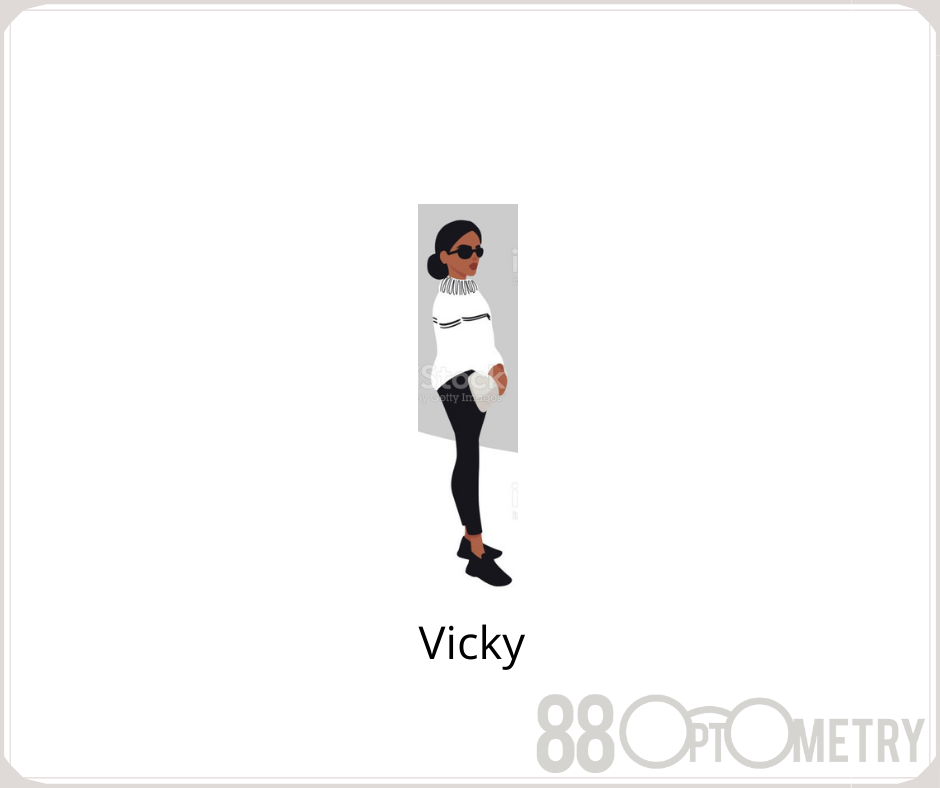Vicky (F/43) a make-up artist, came for eye examination, with complaints of right eye pain after close work & having problem with night driving – as in she cannot gauge the distance/gap between cars and glaring issue with the lights from oncoming cars. She first started experiencing right eye pain after she indulged in hours-long canvas painting about 1.5 years ago. After she finishes her make-up session, she will feel right eye pain & difficulty in driving. She did not really use her existing reading glasses.
Vision without glasses
R: 6/7.5-, 6/6-
L: 6/6-
Existing reading glasses of 1.5 years (1st glasses)
R: +1.00
L: +1.00
Examination shows:
R: PL/-0.75×170 (6/6) [+1.00 blur lens test: 6/7.5-] (patient reported dizzy with -0.75 astigmatism power binocularly)
L: PL/-0.50×10 (6/6) [+1.00 blur lens test: 6/9-] L>R
No hyperopic power is accepted monocularly/binocularly @distance vision
Modified
R: PL/-0.50×170 (patient reported slight shadow underneath & to the right of each of the alphabets on all testing lines)
L: PL/-0.50×10
Add: +1.25 (R>L)
Higher Add is not preferred (higher Add is referred as cloudy day, Add +1.25 is referred as sunny day.. patient likes sunny day)
Range of clear vision can go further away with astigmatism -0.25 in both eyes
Other assessments show:
Examination of Eye Alignment/Posture (Howell Card) by 6^ Base Down on Right eye
Distance: 0 (top arrow paces around 0, slightly on yellow & blue alternately)
With Add Near: 4 XP (blue part)
(normal value: 0-1 EP (yellow part) or 0-3 XP (blue part) @Distance; and 0-6 XP (blue part) @Near)
EP = Esophoria is misalignment of the eye, eye is deviated inwards
XP = Exophoria is misalignment of the eye, eye is deviated outwards
Examination of Eye Alignment/Posture (Maddox Rod)
Distance: vertical white line is oriented 5-10degree (estimated) clockwise & slightly touching on red spotlight
No Add Near: 5 BI
(normal value:
BO/EP = Base Out/Esophoria is misalignment of the eye, eye is deviated inwards
BI/XP = Base In/Exophoria is misalignment of the eye, eye is deviated outwards
NRA (Accommodation analysis – ability to relax accommodation) by plus lens (With Add)
+1.25
(normal value: +1.50 to +2.50)
PRA (Accommodation analysis – ability to stimulate accommodation) by minus lens (With Add)
-0.25
(normal value: -1.37 to -3.37)
MEM – Monocular Estimation Method (Accommodation lag – to measure accommodation response seeing near target) (With Add)
R: reflex very dim
L: +1.00
(normal value: +0.25 to +0.75)
Fusional Reserves (Convergent/Divergent reserve stamina) by Prism Bar (With Add @Near)
Near, Base-Out/Convergent, PFV: 4/10/-1
Near, Base-In/Divergent, NFV: 4/18/16
Distance, Base-In/Divergent, PFV: 2/4/2
Distance, Base-Out/Convergent, NFV: 4/8/6
(normal value: Blur/Break/Recovery)
Near, PFV: 10-28/7-21
Near, NFV: 7-19/5-15
Distance, PFV: 4-18/5-9
Distance, NFV: 4-10/2-6
[Scheiman – Adult Data]
Vergence Facility – ability to make rapid repetitive vergence changes (by Prism Flipper of 12Base Out & 3Base In)
With Add Near: 3 cpm (difficult Base-In)
Distance: 1 cpm (double with Base-Out)
(normal value: 1 cycle = 2 times clearing target
Distance: 12-18 cpm
Near: 12-18 cpm)
Worth 4 Dots
Distance: 4 dots seen (normal)
Near: 4 dots seen (normal)
(normal value: 4 dots seen = normal, 3 dots seen = Right suppression, 2 dots seen = Left suppression)
Amsler Chart
R: normal
L: normal
Interpupillary Distance = 6.0cm

